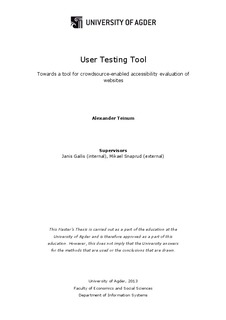| dc.description.abstract | This thesis describes the first open source tool to combine user testing and automated testing to check accessibility of websites. User Testing Tool (UTT) integrates with an existing automated checker for testing websites against the WCAG 2.0 guidelines. UTT generates and presents questions that need human verification, such as wether an alternative text representation is appropriate for an image on a web page. In the future, collected data can be used to both improve the accessibility of the website, as well as making the automatic checker smarter. How to enable more people to improve accessibility testing is the main question addressed. Based on our proposed solution the thesis also deals with how to integrate an automated checker with user testing, how user tests can enhance automated checker tests, how to design the user interface, and how remove any obstacles preventing larger numbers of people to contribute for crowdsourcing the tests of web sites. An open source prototype based on an iframe technique was built to demonstrate a viable path of development. The user interface integrates with the web page to be tested, and it satisfies several usability criteria. The solution covers design of an API for the automatic checker for receiving test results, a control flow mechanism, and a user interface iteratively refined involving evaluators. The user interface is implemented using a SPA architecture, a fat client architecture for the web. This will reduce the demand for bandwidth and server capacity and should therefore be suitable for crowdsourcing. The user interface needs to take privacy into account by giving the user control about what data to collect. Currently this is not a problem since the prototype does not store any data. To initiate the development of a user testing tool, this thesis has focused on a solid architecture along with features that serve a demonstrative purpose. The proposed archtitecture and the open source approach is designed to facilitate further development. Design Research was the chosen research method, where knowledge was derived from creation of the prototype and interaction with the users. The research problem is based on a practical need for better testing tools. User testing of the tool itself uncovered that efficient means of user entry is crucial, and that the tool needs to adjust for a variety of devices and assistive technologies. Future research can include storage of collected data, explore approaches to deal with privacy and logging of data, data analysis for quality assurance, further investigation of the proxy–iframe technique, and integration with the eAccessibility Checker result view. | no_NO |
